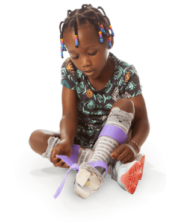Cerebral palsy legal statistics and medical malpractice
Approximately 15,000 to 20,000 medical malpractice claims are filed each year in the United States.
While exact data isn’t available, it is estimated that 25% of all medical malpractice claims involve obstetrics and gynecology, including preventable cerebral palsy (CP).
Here are common medical mistakes leading to cerebral palsy lawsuits:
- Delayed or neglected a necessary cesarean section (C-section)
- Excessive force applied while removing the baby from the birth canal
- Failed to monitor or identify risk factors, such as maternal infection or low birth weight
- Failed to promptly remove the baby from the birth canal during vaginal delivery, resulting in oxygen deprivation
- Improperly used assistive delivery tools like forceps or vacuum extraction
These are only some of the ways medical malpractice can lead to cerebral palsy. If you suspect your child’s CP could have been prevented, you probably have a lot of unanswered questions.
Download our comprehensive guide to get more information.
Causes of cerebral palsy medical malpractice
Cerebral palsy medical malpractice occurs when health care professionals fail to manage pregnancy or delivery complications adequately, leading to brain injuries in the infant from oxygen deprivation or physical trauma.
Learn more about common causes of cerebral palsy medical malpractice.
Failing to monitor fetal heart rate
Monitoring fetal heart rate is crucial, especially in high-risk pregnancies.
Between 6% and 8% of pregnancies are high-risk, according to The University of California, San Francisco Medical Center.
An abnormal fetal heart rate could indicate fetal distress or that the infant is experiencing a lack of oxygen or another issue.
Failing to properly monitor fetal heart rate and failing to recognize and intervene when complications are observed is a medical error that can be devastating for the infant, leading to cerebral palsy and even death.
Labor and delivery mistakes
Cerebral palsy can be the result of mistakes that were made by medical professionals during the birthing process — mistakes that could have been prevented.
It is estimated that up to 50% of birth injuries are preventable and the result of errors made by health care professionals during labor and delivery.
Lack of experience and miscommunication
Some birth injury lawsuits cite a physician’s lack of experience and/or their lack of communication with other medical staff or the mother during labor and delivery.
This may be especially true when babies are delivered by midwives with limited clinical experience or in states where licensing standards for midwives vary significantly.
In the United States, midwives are the primary attendees at 8% of births.
No matter what the cause, when preventable cerebral palsy occurs, families should not be left to face the consequences alone.
Get a free case review to find out if we can help you file a cerebral palsy medical malpractice claim.
Cerebral palsy legal statistics and birth injury lawsuits
A recent study by Boston-based liability insurer Coverys found that 80% of birth injury claims involved cases that were considered severe.
In these cases, infant claims typically fell into three primary categories:
- 41% included neurological or brain damage, like cerebral palsy
- 37% involved shoulder injuries, such as Erb’s palsy
- 34% lead to death or stillbirth (intrauterine fetal demise)
Sadly, this same study found that nearly 1 in 4 birth injury cases involved the death of the mother, the infant, or both.
If you are considering a birth injury lawsuit, it is important to remember that there are strict deadlines called statutes of limitations involved in filing lawsuits.
Each state has its own laws, and failing to file within this period usually means you can no longer file a lawsuit. While it varies by state, most families will have between 1-2 years to take legal action.
Consulting with an experienced cerebral palsy lawyer as soon as possible is the best way to ensure your claim is filed on time.
Cerebral palsy legal statistics and payouts
The average cerebral palsy settlement is estimated at over $1 million. This amount, however, could vary significantly depending on the severity of the condition and other factors.
Examples of cerebral palsy settlements and verdicts include:
- In a case against a Pennsylvania hospital, a delayed C-section led to a child's severe brain injuries and cerebral palsy, resulting in a $183 million jury award.
- An Illinois mother was awarded more than $35 million for her son, who was born with severe cerebral palsy and now uses a wheelchair.
- In another Pennsylvania case, the family of a child diagnosed with cerebral palsy was awarded a settlement of over $10.4 million.
- A New York family was awarded $8.1 million for their child who was born with cerebral palsy, a seizure disorder, and partial blindness.
Studies show that 40% of families of children with special health care needs experience a financial burden due to their child's condition.
Pursuing a settlement through a cerebral palsy lawsuit can help families pay for the medical care and other resources their child needs.
Important cerebral palsy statistics
Cerebral palsy is the most common motor disability that affects infants and children. There is no cure for the condition, and it often requires lifelong care.
Common symptoms of cerebral palsy include impaired muscle tone, issues with walking, and sometimes, intellectual disability and seizures. It's essential for any symptoms to be addressed early on.
According to the Centers for Disease Control and Prevention (CDC), the prevalence of cerebral palsy is higher in Black children than in white children.
Here are additional cerebral palsy statistics:
- 500,000 children under the age of 18 have cerebral palsy in the United States
- Between 1 and 4 of every 1,000 live births result in cerebral palsy
- Every year, between 8,000 and 10,000 babies are diagnosed with cerebral palsy
- 20% of cerebral palsy cases stem from labor and delivery events, while 70% arise from events during pregnancy
- Cerebral palsy is typically not diagnosed until ages 1 to 2
- In a study of 1,319 children with cerebral palsy, 19% had mothers aged 35 or older, and 4% had mothers aged under 20
- Approximately 10% of children develop cerebral palsy due to brain injuries within the first 2 years of life
Other birth injury statistics
Common birth injuries include hypoxic-ischemic encephalopathy (HIE), spinal cord injuries, and cephalohematoma.
Here are additional birth injury statistics:
- 3 out of every 1,000 newborns will experience brain damage, ranging from mild to severe
- About 50% of babies born with Erb's palsy also suffer a broken collarbone
- Birth injuries account for approximately 20% of all infant deaths
- In the United States, 3 babies are born with a birth injury every hour
- Scalp injuries are the most common type of birth trauma, making up 80% of all birth injuries
Caring for a child with cerebral palsy
Cerebral palsy treatment focuses on improving the child's abilities and managing symptoms.
Types of CP vary in symptoms, severity, and treatment options. There are four types of cerebral palsy, with spastic CP being the most common. Athetoid (dyskinetic), ataxic, and mixed cerebral palsy happen less frequently.
Despite advancements in medical care, many children with cerebral palsy, especially those born prematurely, face lifelong costs associated with managing their childhood disabilities and supporting their brain development.
Get legal help for cerebral palsy
Cerebral palsy can bring emotional, physical, and financial challenges. Getting legal help for cerebral palsy can make things easier. The experienced team at Cerebral Palsy Guide is here to guide you and provide the support you need.
We partner with a network of top birth injury law firms across the country. Our legal partners have helped families affected by CP and other preventable birth injuries secure over $1 billion.
Find out if we can help your family with a free consultation right now.



